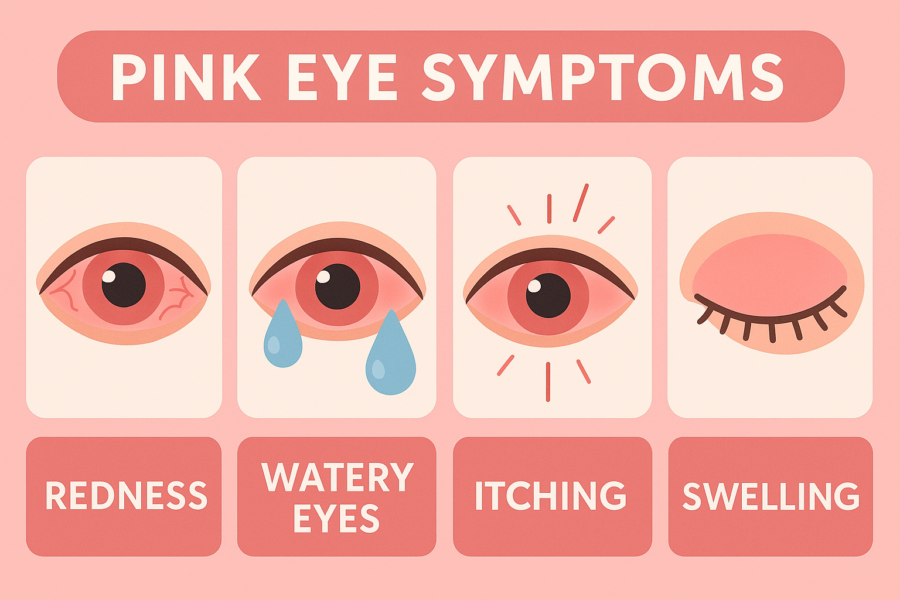Conjunctivitis
Conjunctivitis, or pink eye, is an inflammation of the conjunctiva, the clear mucous membrane that covers the white part of the eyeball and the inside of the eyelid. It is the most common eye infection in the United States. Cases may vary from a mild redness with watery eyes to serious infections where vision is impaired or even lost.
Always Remember…
Whatever irritation may occur, the eye is sensitive and must be treated with great care. When in doubt about any eye problem, call your eye care professional immediately.
What Causes Conjunctivitis?
Conjunctivitis happens when the conjunctiva becomes infected, usually by a virus or bacteria. It also can be caused by allergic reactions or chemical irritations.
Signs/Symptoms of Conjunctivitis
Signs of conjunctivitis are red and irritated eyes. If you have conjunctivitis, you may wake up with your eyelashes stuck together from dried mucus formed during the night. The condition often affects both eyes and causes a gritty feeling in your eyes. Although vision is usually not affected, your eyes may be very sensitive to light. There is a stickiness of the eyelids, and in severe cases the eyelids are swollen. Itching is another common symptom. Conjunctivitis can be confused with a more serious eye disease known as iritis. It is crucial to have your eye problem diagnosed and treated by an eye care professional.
How does conjunctivitis spread?
Anyone can get conjunctivitis since it can be very contagious. The germs that cause conjunctivitis spread easily throughout a household or classroom in a few days. Germs travel from one person’s hands, towels or linens to the next person’s. When that person touches his face or eyes, the infection can be transferred.
How to prevent conjunctivitis from spreading
- Avoid touching or rubbing the infected eye(s).
- Wash your hands often with soap and water.
- Use paper towels instead of cloth towels. If you must use cloth towels, don’t share them.
- Wipe any discharge from eyes at least twice a day or as your eye care professional directs.
- Use facial tissues instead of handkerchiefs.
- Wash any cloth towels, washcloths and linens that you have used in a hot water laundry cycle.
- Do not use contact lenses or eye makeup until your eye is healed.
- To avoid spreading conjunctivitis, keep children or adults home from school or work as directed by your eye care professional.
How is conjunctivitis treated?
Antibiotic eye drops, ointments or other medications may be prescribed. Cleaning the crusting on the eyelids every few hours with a cotton swab soaked in lukewarm water usually helps the eye feel better. Tinted glasses may relieve discomfort from bright light. Do not cover the eye with a patch, as this can make the infection worse.
Although many types of conjunctivitis may clear up on their own, it is best to have an examination by your eye care professional to determine the cause and right treatment.
Types of conjunctivitis
Viral: Viral conjunctivitis is very common. Sometimes it is linked with a low-grade upper respiratory condition that seems to be a common cold. Inflammation of the cornea often goes along with viral conjunctivitis.
Allergic: Pollen, cosmetics, chemicals in the air or dust can cause allergic conjunctivitis. It usually affects both eyes. Symptoms include extreme itching, mucousy discharge, moderate redness, tearing and sometimes nasal discharge and head congestion. Hay fever and upper respiratory infections often go along with allergic conjunctivitis. The skin and eyelids may become inflamed, swollen and itchy.
Bacterial: Bacterial conjunctivitis is very common and may start quickly or over a period of days. Symptoms can be mild or severe, depending on the type of bacteria involved and the general health and natural resistance of the infected person.
Chemical/toxic: Direct contact with noxious fumes, particles or chemical fluids may cause a red eye with tearing, pain and sensitivity to light. The severity depends on the type of chemical and the length of time the eye was exposed to it.


